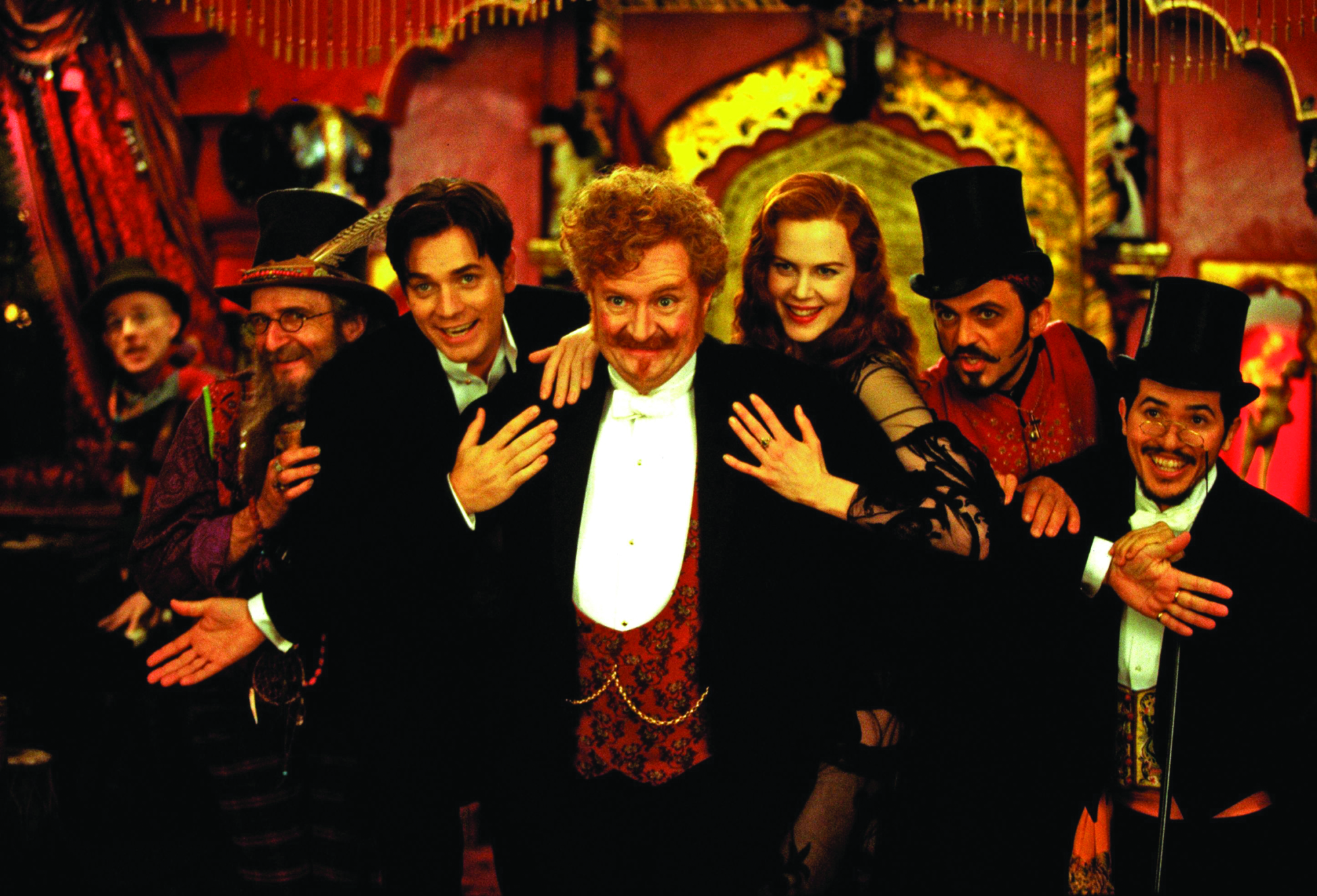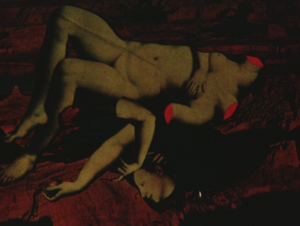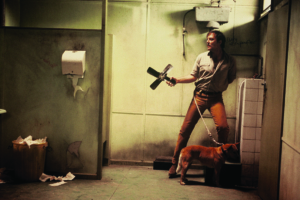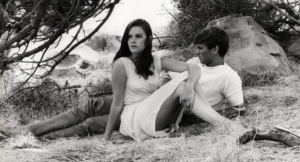Before it even truly begins, the period musical Moulin Rouge! (Baz Luhrmann, 2001) invites us into the spectacle at its heart: behind an onstage conductor leading an unseen orchestra, a red curtain is drawn to reveal a white screen, onto which is projected a series of silent-film-style title cards listing credits and the words ‘Paris, 1900’. This sense of constructedness is maintained as the first character we meet, Toulouse (John Leguizamo), materialises – in black-and-white, framed by graphical L-brackets – to sing the film’s prologue, ‘Nature Boy’. We get a ghostly glimpse of our protagonist, Christian (Ewan McGregor), then the camera launches over Paris and weaves through alleyways. As the screen slowly fills with colour and the camera finally rests on Christian’s face, Toulouse’s song crescendoes with the film’s ostensible moral: ‘The greatest thing you’ll ever learn / Is just to love and be loved in return.’
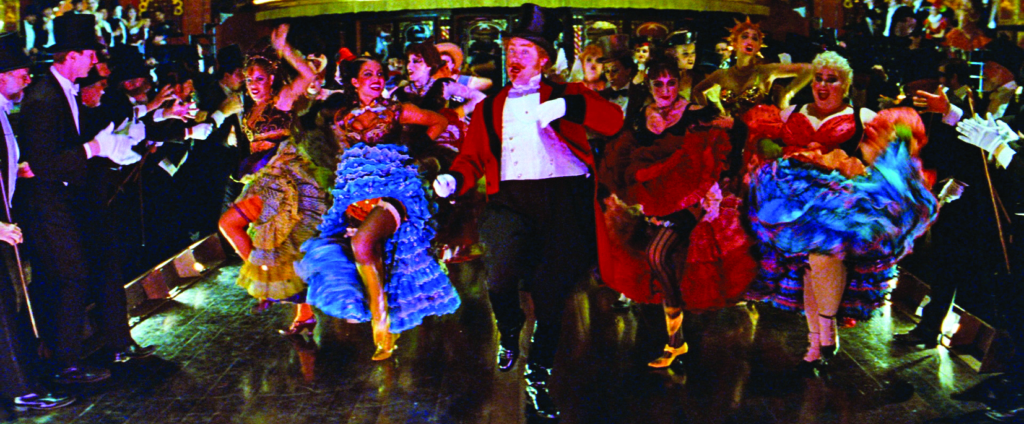
Except our story actually takes place the year before; 1900 marks the time when Christian, a writer, is chronicling his relationship with Satine (Nicole Kidman), who has died. At various points throughout, his voiceover signposts key events in the narrative: how he’d moved from London to the French capital in search of inspiration; how he’d fallen in with Toulouse and his merry band of ‘bohemians’; how he’d fallen in love with the courtesan Satine; how their love was impeded by Satine’s betrothal to The Duke (Richard Roxburgh); how he lost Satine to illness. Prior to all of these, however, he offers a description of the titular setting:
The Moulin Rouge – a nightclub, a dance hall and a bordello ruled over by Harold Zidler [Jim Broadbent]. A kingdom of night-time pleasures where the rich and powerful came to play with the young and beautiful creatures of the underworld.
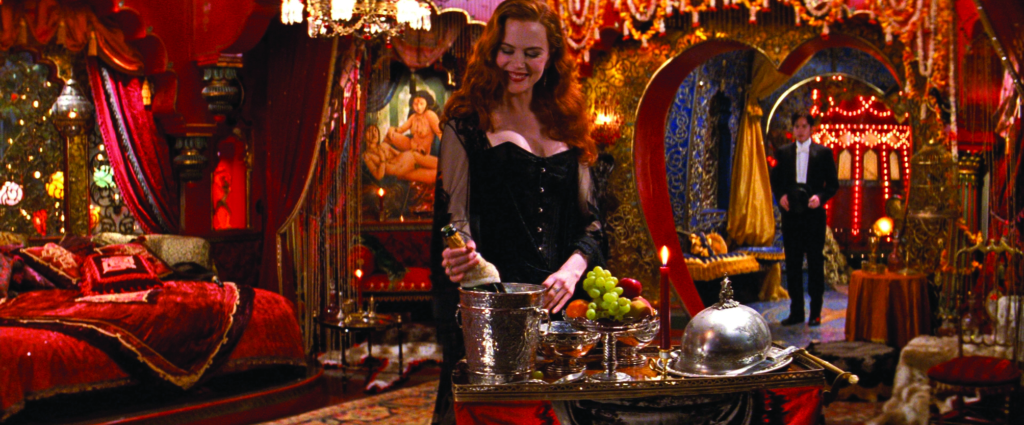
Hearing these words, I was instantly reminded of old-school carnivals – largely nocturnal entertainment complexes that, for a finite period, gave reprieve from the pressures and pains of daily life. They also brought to mind the carnivalesque: an artistic mode identified by literary theorist Mikhail Bakhtin that destabilises meaning and convention by sowing seeds of radicalism in a text’s finer details.[1]Mikhail Bakhtin, ‘Rabelais and His World’, trans. Hélène Iswolsky, 1984 [1965], in Pam Morris (ed.), The Bakhtin Reader: Selected Writings of Bakhtin, Medvedev, Voloshinov, Edward Arnold, London, 1994, pp. 195–206. While this concept is ordinarily examined with reference to works that overtly embody it – the films of Alfred Hitchcock[2]See David Sterritt, ‘The Diabolic Imagination: Hitchcock, Bakhtin, and the Carnivalization of Cinema’, Hitchcock Annual, vol. 1, 1992, pp. 39–67. and Wes Craven,[3]See Patrick Fuery, ‘The Carnivalesque: Film and Social Order’, in New Developments in Film Theory, St. Martin’s Press, New York, 2000, p. 110. the myriad films that feature clowns[4]See Moritz Fink, ‘Phallic Noses, Blood-filled Balloons, Exploding Popcorn, and Laughing-gas-squirting Flowers: Reading Images of the Evil Clown’, in John A Dowell & Cynthia J Miller (eds), Horrific Humor and the Moment of Droll Grimness in Cinema: Sidesplitting sLaughter, Lexington Books, Lanham, MD, 2018, pp. 29–42. – I’ve found it useful as an analytical framework for cracking open less obvious examples. Moulin Rouge! is one such case.
With the twentieth anniversary of the film almost upon us, not to mention a live stage reimagining already in our midst,[5]Adam Green, ‘Moulin Rouge! Is Reinvented for the Stage – and a New Generation’, Vogue, 11 June 2019, <https://www.vogue.com/article/moulin-rouge-vogue-july-issue-2019>, accessed 29 July 2020. there’s no better time than now to revisit this new-millennial blockbuster. The critical response to it upon its release – ‘a karaoke musical’ defined by ‘real artifice’,[6]Kent Jones, ‘Real Artifice’, Film Comment, vol. 37, no. 3, May/June 2001, p. 22. ‘an extravagant exercise in style’,[7]Adrian Martin, ‘Moulin Rouge’, Adrian Martin official website, March 2001, <http://www.filmcritic.com.au/reviews/m/moulin_rouge.html>, accessed 31 July 2020. ‘deliberately simplistic’[8]Jonathan Dawson, ‘The Fourth Wall Returns: Moulin Rouge and the Imminent Death of Cinema’, Senses of Cinema, issue 14, June 2001, <http://sensesofcinema.com/2001/essays-on-films-14/moulin_rouge/>, accessed 31 July 2020. – may have been mostly dismissive, but recent opinion has definitely warmed in line with the largely favourable general-public response.[9]See ‘Moulin Rouge!’, Rotten Tomatoes, <https://www.rottentomatoes.com/m/moulin_rouge_2001>, accessed 31 July 2020. Moreover, set in the countercultural district of Montmartre, centring on a cohort of artists and undesirables, and propelled by a protagonist aspiring to become a ‘bohemian revolutionary’, Moulin Rouge! has all the ingredients for a truly transgressive piece of cinema. But how do (decadent) style and (romantic) substance work together in Luhrmann’s ‘spectacular spectacular’?
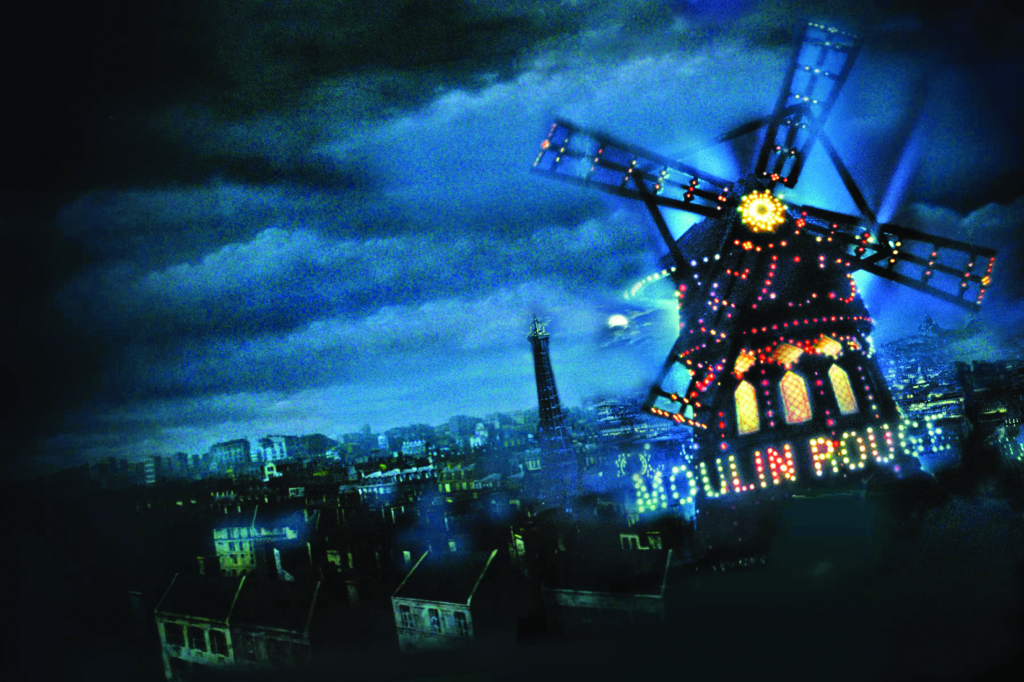
‘Here we are now – entertain us’
In ‘Rabelais and His World’, Bakhtin examines the mechanisms by which medieval carnivals created an alternate world ‘outside officialdom’, where conventional power hierarchies were dissolved and protocol was dispensed with. What these achieved was a form of ‘societal reversal’, however short-lived, that granted the lower classes respite from any sense of discontent. In inviting all citizens, no matter their station, to partake in libations and merriment, carnivals also allowed the citizenry to reconnect with their ‘animalistic’ urges, which are ordinarily subdued by sombre labour and subordination to law. But carnivals weren’t held to valorise revelry over rationality or humour over authority, and nor did they exist to oppose the prevailing order outright. As a temporary event held within the jurisdiction of the State, the carnival naturally relied on the endorsement of those in power – which was secured only through the promise of plebeian catharsis (and, thus, the quashing of revolt).[10]Bakhtin, op. cit., pp. 197–9. The eventual suppression of physical carnivals from the Renaissance onwards paved the way, in their stead, for an artistic style or mode that preserved their transgressive spirit: the carnivalesque. This form of expression found a particularly conducive home in avant-garde art, which favoured subject matter and styles deemed unfit for mainstream, canonical consumption.[11]Robert Stam, Subversive Pleasures: Bakhtin, Cultural Criticism, and Film, Johns Hopkins University Press, Baltimore, 1989, pp. 98–9 Yet, despite the change in form, Bakhtin stresses that ambivalence has remained central to the carnival/esque: it subverts and sustains the status quo by providing a contained outlet for resistance.[12]Bakhtin, op. cit., pp. 197–9.
In inviting all citizens, no matter their station, to partake in libations and merriment, carnivals also allowed the citizenry to reconnect with their ‘animalistic’ urges, which are ordinarily subdued by sombre labour and subordination to law.
Luhrmann’s handiwork may not strictly count as avant-garde, but critics were nonetheless quick to point out its innovations in editing and cinematography.[13]See, for example, Jones, op. cit., p. 22; and Marsha Kinder, ‘Moulin Rouge’, Film Quarterly, vol. 55, no. 3, Spring 2002, pp. 52–4. In this way, Moulin Rouge! already invites identification with the carnivalesque – something only emphasised by its opening sequences that disorient rather than guide the audience into its world. Building on the introductory section’s false starts and high degree of self-reflexivity, these scenes presage the film’s many subsequent frenetic cuts, hyperactive zooms and occasional gravity-defying shots. After lingering on the desaturated, monochrome calm of Christian’s face, we are confronted with a montage of scenes inside the Moulin: figures dancing, gaudy outfits, bosoms and groins, maniacal laughter, a clown, smiling faces made grotesque by zoom and slow motion. When Christian first meets the bohemian cabal, they are portrayed hyper-comically: Toulouse as a ‘a dwarf dressed as a nun’; the narcoleptic Unconscious Argentinian (Jacek Koman), falling through the ceiling; the keyboardist Satie (Matthew Whittet), tinkering with synthesisers; The Doctor (Garry McDonald), draped with numerous trinkets; the androgynous playwright Audrey (David Wenham), storming out dramatically when threatened by Christian’s literary gifts. Scarcely ten minutes into the film, the men drink absinthe, and diegetic reality turns hallucinogenic: a garble of magic sparkles, the Green Fairy (Kylie Minogue), garish expressions and dancing on roofs.
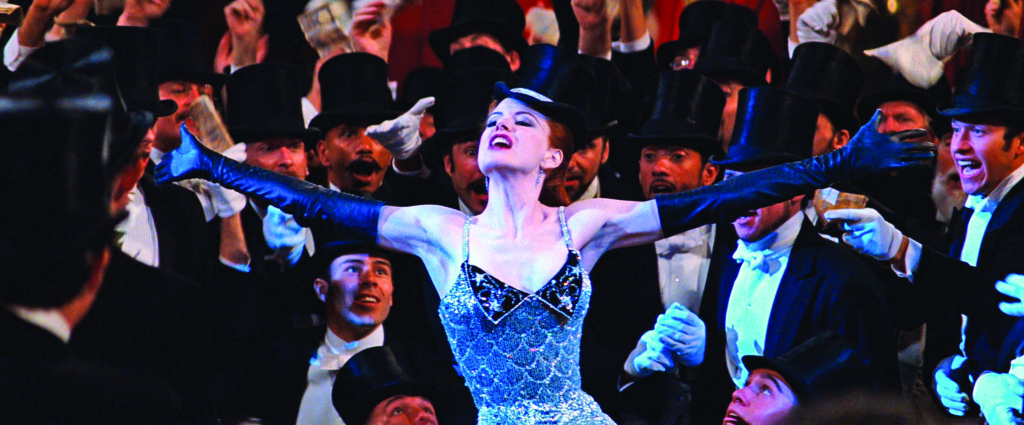
This carnivalesque quality is cranked up when we enter the Moulin in earnest. Zidler beckons us through red curtains. His ‘Diamond Dogs’ do cancan kicks and make come-hither faces to the song ‘Lady Marmalade’. Shots of groins and bosoms and faces. Male patrons, uniformly in black suits and top hats, demand service amid the anthemic ‘Smells Like Teen Spirit’. Courtesans and customers perform synchronised choreography. Gratuitous shots of sideshow acts (a boxer, a mermaid, a snake charmer, tattooed men, twins). Zidler flies above Paris, then backflips back inside. Scenes of flirting, groping, vertical dancing turning horizontal. And, in case this assault on the senses isn’t enough to foreshadow the carnivalesque content to come, Luhrmann plays ventriloquist to make the message plain: ‘Got some dark desire / Love to play with fire / Why not let it rip? / Live a little bit,’ intones Zidler, summoning more patrons (and us). ‘’Cause it’s good for your mind!’ chirps Christian, having settled into the mayhem.
‘The rhythm of the night’
Film is an especially potent medium for the carnivalesque, owing to its high level of verisimilitude; the transmission of ideology is most effective, after all, when the ideological machine renders itself invisible.[14]See Edward S Herman & Noam Chomsky, Manufacturing Consent: The Political Economy of the Mass Media, Pantheon Books, New York, 1988. In fact, while the carnivalesque’s affinity with the avant-garde may suggest an eschewal of the realism of mainstream texts,[15]See Stam, op. cit., pp. 100, 109–10. film scholar Patrick Fuery observes that it also can’t avoid relying on what cultural theorist Roland Barthes has called the ‘reality effect’: the adoption of specific formal choices to lend a work of art more ‘reality’. Here, again, we see the ambivalent nature of the carnivalesque. On the one hand, it pushes back against traditional realist techniques; on the other, it recognises the need for a faithful emulation of the external world’s social order in the dramatised one.[16]Fuery, op. cit., pp. 110, 123–4. What makes Moulin Rouge! a tremendously interesting study in this regard is its blend of realistic storyline and anti-realist style. As previously mentioned, the film is a dizzying mosaic of energetic editing, volatile shot sizes and tapestries upon tapestries of electric colour and sound; Luhrmann himself has associated Moulin Rouge!’s aesthetic with MTV.[17]Baz Luhrmann, quoted in Andrew L Urban, ‘Moulin Rouge:Orpheus Downunderworld’, Urban Cinefile, 24 May 2001, <https://www.urbancinefile.com.au/home/view.asp?a=4859>, accessed 29 July 2020. For the director, what this achieves is greater clarity:
Most of the naturalistic cinema that’s been the vogue for years puts the audience to sleep and asks it to look at reality through a keyhole. We’re doing the exact reverse […] You use all this crazy artifice to reveal the truth.[18]Baz Luhrmann, quoted in Graham Fuller, ‘Baz Knows the Score’, The Observer, 19 August 2001, <https://www.theguardian.com/film/2001/aug/19/features>, accessed 1 August 2020.
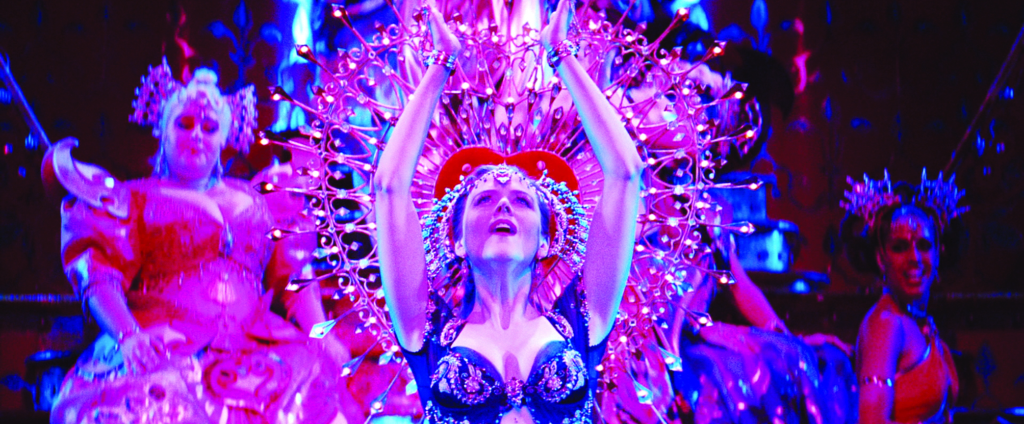
But then there is the task of ascertaining that ‘truth’, and figuring out how the carnivalesque factors into it. Notwithstanding the intrinsically interpretative nature of film viewing, it’s worth noting that carnivalesque elements don’t necessarily present across the entirety of a film. Of the four ‘levels’ of meaning identified by cinema-studies heavyweights David Bordwell and Kristin Thompson,[19]David Bordwell & Kristin Thompson, Film Art: An Introduction, 2nd edn, Alfred A. Knopf, New York, 1986, pp. 30–3. I’d argue that, for most films, the carnivalesque is only viable in the two higher levels – implicit (‘suggested meaning’) and symptomatic (responses to ‘a set of social values’) – as the referential (‘bare-bones plot summary’) and explicit (‘openly asserted meaning’) levels are perhaps too uncomplicated to deconstruct. Earlier, I cited what I consider to be Moulin Rouge!’s explicit meaning, courtesy of Toulouse’s prologue-song, and an extempore articulation of its referential meaning would be something like: ‘A writer falls in love with a courtesan, but their romance is thwarted by protocol and illness.’ Both readings are unequivocally conventional (film history is replete with doomed-love stories, while the ‘dying girl’ has emerged as a trope of its own[20]See Jessica Kiang, ‘Not Another Dying Girl: How Shannon Murphy’s Babyteeth Challenges a Weary Trope’, Metro, no. 204, 2020, pp. 8–15.), and therefore also highly hegemonic – denying Moulin Rouge! the ambivalence necessary for a ‘carnivalesque’ assignation.
And so we herald in the film’s implicit and symptomatic meanings, which are much less obvious. Potential implicit readings could be: ‘Reciprocated passion must be tempered with practicality’; or, ‘The pursuit of love sometimes calls for danger and deceit’; or, ‘Love isn’t as all-powerful as “silly love songs” posit.’ It could even be – as The Unconscious Argentinian utters, prior to singing ‘El tango de Roxanne’ – the cruel ‘Never fall in love with a woman who sells herself’, a passing comment channelling insidious whorephobic sentiment that dehumanises women who engage in sex work.[21]See Gala Vanting, ‘Attention Whores: Sex Work as Spectacle’, Archer, no. 11, December 2011, pp. 20–5, available at <http://archermagazine.com.au/2019/06/attention-whores-sex-work-as-spectacle/>, accessed 1 August 2020. (The film’s symptomatic readings are even more expansive – and I’ll return to these later – but, for now, let’s say they coalesce around the themes of protest, class and death.)
The film is a dizzying mosaic of energetic editing, volatile shot sizes and tapestries upon tapestries of electric colour and sound; Luhrmann himself has associated Moulin Rouge!’saesthetic with MTV.
In arriving at these interpretations, I have fallen back on Fuery, who has devised an exhaustive list of themes and motifs that indicate a film’s carnivalesque disposition[22]Fuery, op. cit., pp. 117–22. (the ones I’ve used, retaining Fuery’s wordings, are designated in the following paragraphs using italics). Arguably the most conspicuous in Moulin Rouge! is historically recognisable but distorted time periods. According to Luhrmann, the choice of era was informed by resonances between the two turn-of-the-century periods – both involving a ‘world […] moving forward and backwards’[23]Baz Luhrmann, quoted in Geoff Andrew, ‘Baz Luhrmann’, The Guardian, 7 September 2001, <https://www.theguardian.com/film/2001/sep/07/1>, accessed 1 August 2020. – and this led him to devise a temporal setting that was ‘at once exotic yet also recognisable’.[24]Luhrmann, quoted in Urban, op. cit. It’s relevant to mention, too, that the film both makes use of and muddles several real-life figures: painter Henri de Toulouse-Lautrec, pianist Erik Satie, proprietor Charles Zidler. Moulin Rouge!’s emphasis on liminal spaces and marginalisation is another. It’s immediately noticeable that many scenes are bathed in darkness (shadows, insufficient light, night-time, concealed areas like room corners or behind curtains), and the Moulin’s status as a purveyor of illicit activities is denoted by its location at the city’s fringe[25]The Moulin was technically located within what was, at the time, the Paris city centre, but was geographically closer to the then working-class ghetto and red-light district of Montmartre; see Nicolas Kenny, ‘Je Cherche Fortune: Identity, Counterculture, and Profit in Fin-de-siècle Montmartre’, Urban History Review, vol. 32, no. 2, Spring 2004, pp. 22–6. and its nocturnal opening hours – away from the ‘brightness’ of accepted society. More profoundly, Luhrmann has articulated his film’s basis in the Ancient Greek myth of Orpheus,[26]See Urban, op. cit.; Jones, op. cit.; and Fuller, op. cit. with the Moulin standing in for the underworld (and Zidler himself frequently refers to it as such). Together with the blurred sense of history, this shadowy handling of place and ‘downward’ orientation that foregrounds death and the abject[27]Bakhtin, op. cit., p. 206. For more on the abject, see Julia Kristeva, Powers of Horror: An Essay on Abjection, trans. Leon S Roudiez, Columbia University Press, New York, 1982 [1980]. buttress Moulin Rouge!’s carnivalesque essence.
Elsewhere, we can detect a preponderance of carnivalesque elements. The representations of excess and the grotesque foreshadowed in the introductory sequences are matched by later ones (depictions of bacchanalian acts involving alcohol, nudity and orgiastic behaviour; extreme close-ups of faces that straddle comical and absurd). There are plentiful dream-like and dreaming sequences, most notably when Christian sneaks into Satine’s boudoir to serenade her; the film’s symbolic rendering of the moment the pair fall for each other shows them leaping out the window to dance among clouds against a starry night reminiscent of the eponymous painting by Vincent van Gogh (another late-nineteenth-century Montmartre local). Themes of social disruption are invoked prominently in the film’s frequent references to the bohemian revolution and in the symbolism of a band of ‘penniless’ artists challenging ‘the Man’, incarnated in the noble-titled Duke.
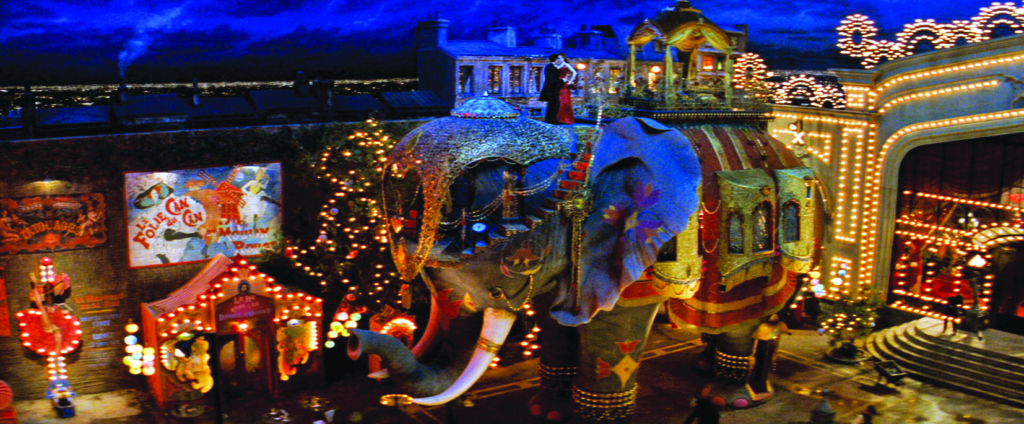
‘The children of the revolution’
What makes the identification of symptomatic meaning/s difficult, whether they be carnivalesque-inflected or otherwise, is the requirement that the work be evaluated with recourse to the real world. For a film like Moulin Rouge! that deliberately plays with our understanding of history – and is, in large part, structured around and about play itself – this task proves even more arduous. Which aspects of the story and style enact play-as-critique, and which are for play-as-frivolity? ‘We’re not just in the world of Montmartre; we’re in the world of music and movie quotations,’ quipped Luhrmann at the time of the film’s release.[28]Luhrmann, quoted in Fuller, op. cit. Any reference that ‘serves the revelation of the human condition’ was fair game, he explained, elsewhere.[29]Luhrmann, quoted in Jones, op. cit., p. 22. Watching the film today, in a world wherein ‘personal brands’ have become de rigueur and politics are professed through hashtags and memes, I couldn’t help but find its elevation of appearances and spectacle even more compelling.[30]For more on this, see Adolfo Aranjuez, ‘2020 Vision and Optical Illusions’, Meanjin, vol. 79, no. 3, Spring 2020, pp. 1–6.
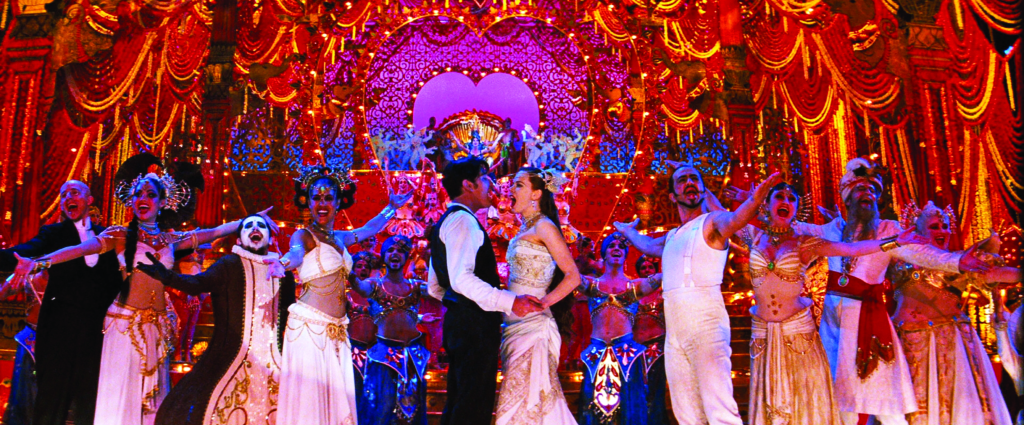
Analysing the real-world structure, scholar Will Visconti writes that the Moulin was defined by the ‘crossing [of] boundaries of class, culture and history’, which ‘created a sense of ambiguity and [a] melding of the lucid and lewd’ and ‘enhanc[ed] the interplay of looking and being looked at’.[31]Will Visconti, ‘Playtime at the Moulin Rouge’, Essays in French Literature and Culture, no. 50, November 2013, pp. 114, 108. The egalitarianism hinted at by these descriptions calls to mind the ‘flattening’ of societal hierarchies espoused by Bakhtin’s carnival/esque, and depictions of it undoubtedly populate Luhrmann’s film. If this factual equivalence is to hold up, however, it’s important to re-emphasise the temporary and ultimately hegemonic nature of the carnival/esque. In light of its role as a mechanism by which to contain and quell protest, what are we to make of the assorted bohemians of the film’s milieu, the so-called ‘children of the revolution’?
A third of the way through the film, after securing The Duke’s financial investment in their theatrical production ‘Spectacular Spectacular’, Toulouse drunkenly proclaims, ‘The bohemian revolution is here!’ That his yardstick for the arrival of a society-transforming movement is the commissioning of a play is telling, for it reveals just how facile his cabal’s motivations are. This could be dismissed as mere careless writing on the part of Luhrmann and co-scribe Craig Pearce, or an oversimplified reading; what’s fascinating, though, is the degree to which it mirrors actual history. A detailed exploration of Parisian bohemianism is beyond the scope of my essay, but suffice it to say that many of the artists who made Montmartre their home had affluent origins. As historian Nicolas Kenny outlines, their decision to move there was an exercise in ‘finding beauty in an urban underworld of prostitutes and criminals’:
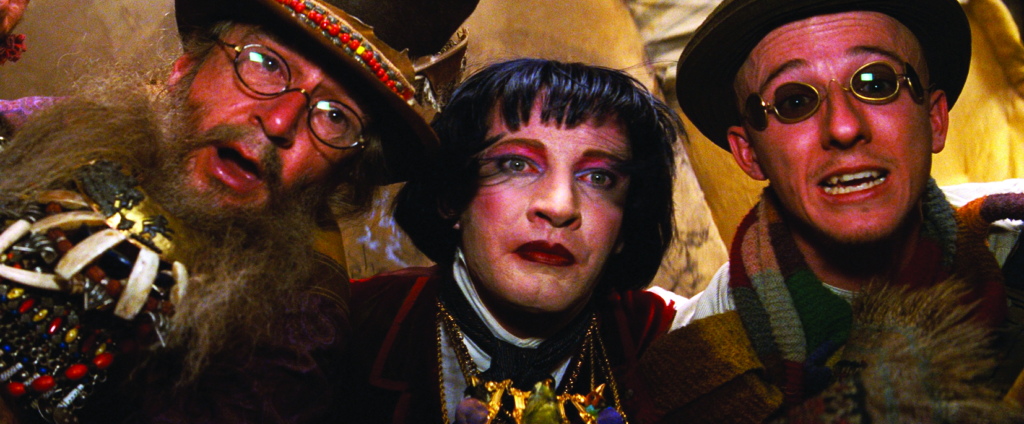
By choosing to make the low-brow nature of their surroundings the focus of their lives and work, Montmartre’s poets and painters rejected […] conventional, Academic art [… But] class distinctions persisted in Montmartre, and the community remained a primarily masculine domain.[32]Kenny, op. cit., p. 26.
Whiffs of this type of anti-Establishment performativity are present (intended or not) in the film’s first act, distilled in the figure of Christian. Our protagonist is forthright in admitting that ‘the world had been swept up in a bohemian revolution, and [he] had come to be a part of it’. Soon after his arrival, he experiences involuntary visions of his (aristocratic-looking) father scolding him for his ‘ridiculous obsession’ with creativity and love. And, most damningly, when Christian dons a black suit and top hat to ‘appear’ bourgeois at the Moulin, he disappears into the sea of suited-up men alongside The Duke. This optical effect is intensified when both of them first lay eyes on Satine: each man is on either side of a shared wall, in a mirrored composition, simultaneously ogling the girl they wish to get. Here, we’re invited to recognise the shared experiences between The Duke and Christian – and, arguably, between the bourgeois men and the self-professed bohemians who’ve planted roots in Montmartre, whom Christian has sought to join. If history is adhered to in this period retelling, this means that all of these men have access to money and mobility (in spite of their current chosen circumstances), while the underworld creatures of the Moulin are restricted to their carnival ‘cage’.
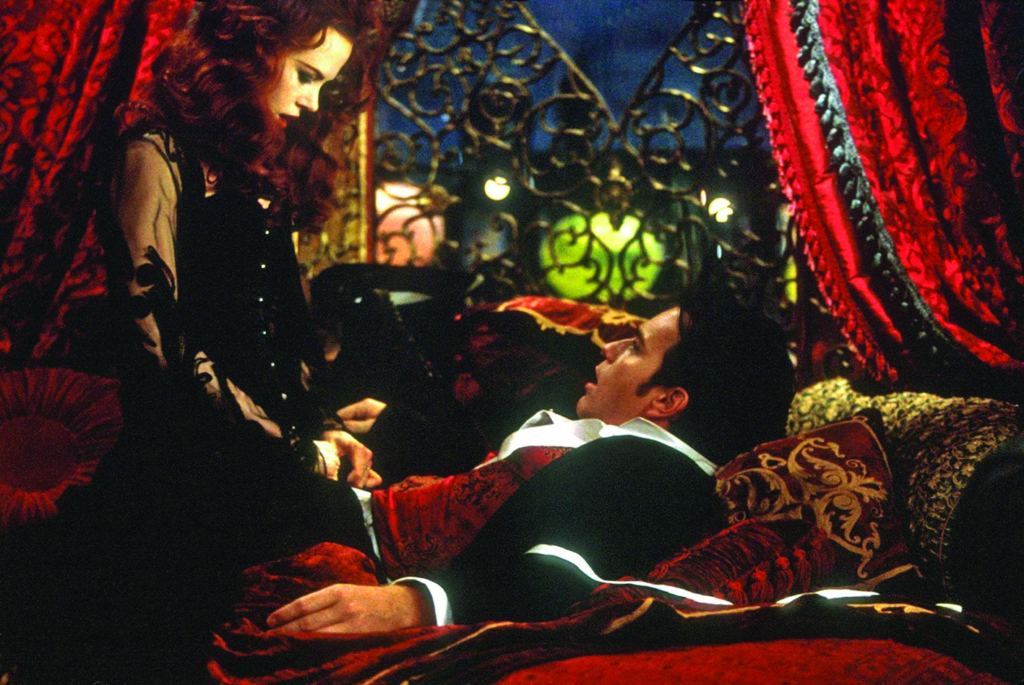
This brings us, of course, to Satine. For a story ostensibly about the love between two people, Moulin Rouge! overwhelmingly sidelines Satine, who is reduced not only to the roles of love/sex object and dying girl, but also that of manic pixie dream girl[33]See Hugo Schwyzer, ‘The Real-world Consequences of the Manic Pixie Dream Girl Cliché’, The Atlantic, 9 July 2013 <https://www.theatlantic.com/sexes/archive/2013/07/the-real-world-consequences-of-the-manic-pixie-dream-girl-clich-233/277645/>, accessed 1 August 2020. and an embodiment of the Madonna/whore dichotomy – a woman expected to be both sexually experienced and virginal, both available and unattainable.[34]See Marina Della Giusta & Laura Scuriatti, ‘The Show Must Go On: Making Money Glamorizing Oppression’, European Journal of Women’s Studies, vol. 12, no. 1, 2005, pp. 32–6. This framing, despite aligning with the real-world period’s broader misogyny, offers insights into the insidious side of the carnival/esque and the patriarchal societies in which it operates. If the Moulin-as-carnival can only exist with State endorsement, and if we are to regard Satine – its ‘sparkling diamond’, whose power lies only in ‘mak[ing] men believe what they want to believe’ during paid-for sessions – as its encapsulation, then her being governed by three male figures cements this hegemonic dynamic. In every respect, Satine is spoken for: Zidler oversees every aspect of her work and life; The Duke, her security and future; and Christian, her survival and emotional stability. The dominating tendencies of the first two perhaps go unquestioned, as their treatment of Satine parallels their influence on the non-human world: Zidler is the custodian of the Moulin, while The Duke is one of the powerbrokers beyond it. Christian, on the other hand, is a tougher nut to crack; as the story is told from his perspective, we are sympathetic to him by default. However, it’s not irrelevant that his ‘affection’ for Satine soon manifests in jealousy-fuelled attempts at control and emotional guilting – predictable (though troubling) responses given she addresses his personal and artistic ‘problem’ of having ‘never been in love’ before. Following her death, it even extends to taking ownership of ‘their’ story. Across 127 minutes, we learn nothing of Satine’s past; we know barely any of her dreams or fears, beyond her wish to become an actress and her solo ‘One Day I’ll Fly Away’ (a Chekhov’s gun that fires, in time, to remind us that flight is a privilege reserved for a select few).
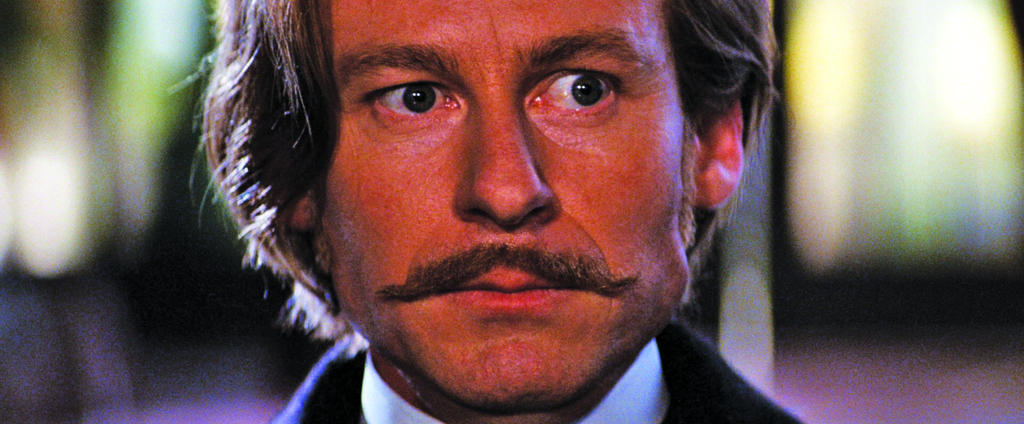
‘We could steal time just for one day’
Moulin Rouge!, for Luhrmann, is ‘about growing up and […] realis[ing] there are things bigger than yourself’:
People die and relationships end. We’ve all been young men or women who dreamt of being creative, who rejected our bourgeois backgrounds, who’ve gone to the city […] and fallen into some incredible relationship that is purely romantic and related to that moment. But that relationship cannot be, and it passes on by.[35]Luhrmann, quoted in Fuller, op. cit.
This ‘we’ merits interrogation. Unlike Christian and privileged individuals like him, Satine and her Moulin colleagues (and their counterparts in the modern day) are unable to simply uproot and attempt new lives elsewhere, with a familial safety net and a warm bed to return to if everything fails. It’s this hinted-at critique of class – the depiction of love and art as luxuries – that I regard as the film’s most formidable carnivalesque expression. In the courtship song ‘Elephant Love Medley’, Satine rebuts Christian’s lofty, lovelorn rhetoric with reminders of her hard life: the need to put food on the table, the need for shelter and safety. These very things are promised her by The Duke (with Zidler’s mediation), along with the fulfilment of her acting dream (through the now-financed ‘Spectacular Spectacular’). Yet Christian croons: ‘All you need is love.’ Later, fearing retribution from The Duke after Satine rebuffs his advances, Christian schemes to leave Paris and take her with him: ‘I don’t care about the show. We have each other – that’s all that matters.’ But Satine is dying; poised, in her final days, between love and accomplishment, between frivolous flight and responsibility, between three men, she chooses herself.
Moulin Rouge! may appear to be a straightforward romance-musical. In many ways, it is. But careful attention to its subtler, carnivalesque messages reveals intricate commentaries on superficial protest, middle-class privilege, art-fuelled escapism and mortality.
After performing in ‘Spectacular Spectacular’, Satine dies in Christian’s arms, surrounded by shadows and the underworld folk. Beyond the curtain, the audience applauds, relishing their artistic gratification and ready to return to their lives outside the Moulin. The camera slowly floats up, then across the Moulin towards Christian’s apartment; the funereal pace of this single shot is a stark contrast to the feverish editing of all that’s come before. Night turns to day, except it’s been months, and we see Christian bathed, for the first time, in sunlight – he, too, has emerged from the underworld of the Moulin. Typing ‘The end’ on his manuscript, he’s accomplished what he’d set out to do, and is perhaps ready to move on from this ‘moment’ in his life. All the while, the inescapable, hard toil of survival continues within the Moulin and in Montmartre. ‘We can’t afford to love,’ Zidler told Satine earlier in the film.
With its vibrant visuals and uplifting songs, Moulin Rouge! may appear to be a straightforward romance-musical. In many ways, it is. But careful attention to its subtler, carnivalesque messages reveals intricate commentaries on superficial protest, middle-class privilege, art-fuelled escapism and mortality. Indeed, that the line ‘I will love you until my dying day’ appears in the film’s central ballad, ‘Come What May’, gives it a clairvoyant quality, especially when heeding the penultimate line of Satine’s aforementioned solo: ‘Why live life from dream to dream / And dread the day when dreaming ends?’ In positioning love as its ‘dominant moralizing refrain’ (in the words of critic Marsha Kinder),[36]Kinder, op. cit., p. 52. Moulin Rouge! prophesies its own defeat. Death draws the curtain on Satine, on the carnival, on Christian’s search for a muse, on this film’s version of revolution; and, like Orpheus, whose hubris dooms his paramour Eurydice, Christian is forced to reckon with forces that are much, much greater than love. Contrary to our hero’s edicts, it seems romance – and romanticism – is neither ‘all you need’ nor the greatest lesson.
Endnotes
| 1 | Mikhail Bakhtin, ‘Rabelais and His World’, trans. Hélène Iswolsky, 1984 [1965], in Pam Morris (ed.), The Bakhtin Reader: Selected Writings of Bakhtin, Medvedev, Voloshinov, Edward Arnold, London, 1994, pp. 195–206. |
|---|---|
| 2 | See David Sterritt, ‘The Diabolic Imagination: Hitchcock, Bakhtin, and the Carnivalization of Cinema’, Hitchcock Annual, vol. 1, 1992, pp. 39–67. |
| 3 | See Patrick Fuery, ‘The Carnivalesque: Film and Social Order’, in New Developments in Film Theory, St. Martin’s Press, New York, 2000, p. 110. |
| 4 | See Moritz Fink, ‘Phallic Noses, Blood-filled Balloons, Exploding Popcorn, and Laughing-gas-squirting Flowers: Reading Images of the Evil Clown’, in John A Dowell & Cynthia J Miller (eds), Horrific Humor and the Moment of Droll Grimness in Cinema: Sidesplitting sLaughter, Lexington Books, Lanham, MD, 2018, pp. 29–42. |
| 5 | Adam Green, ‘Moulin Rouge! Is Reinvented for the Stage – and a New Generation’, Vogue, 11 June 2019, <https://www.vogue.com/article/moulin-rouge-vogue-july-issue-2019>, accessed 29 July 2020. |
| 6 | Kent Jones, ‘Real Artifice’, Film Comment, vol. 37, no. 3, May/June 2001, p. 22. |
| 7 | Adrian Martin, ‘Moulin Rouge’, Adrian Martin official website, March 2001, <http://www.filmcritic.com.au/reviews/m/moulin_rouge.html>, accessed 31 July 2020. |
| 8 | Jonathan Dawson, ‘The Fourth Wall Returns: Moulin Rouge and the Imminent Death of Cinema’, Senses of Cinema, issue 14, June 2001, <http://sensesofcinema.com/2001/essays-on-films-14/moulin_rouge/>, accessed 31 July 2020. |
| 9 | See ‘Moulin Rouge!’, Rotten Tomatoes, <https://www.rottentomatoes.com/m/moulin_rouge_2001>, accessed 31 July 2020. |
| 10 | Bakhtin, op. cit., pp. 197–9. |
| 11 | Robert Stam, Subversive Pleasures: Bakhtin, Cultural Criticism, and Film, Johns Hopkins University Press, Baltimore, 1989, pp. 98–9 |
| 12 | Bakhtin, op. cit., pp. 197–9. |
| 13 | See, for example, Jones, op. cit., p. 22; and Marsha Kinder, ‘Moulin Rouge’, Film Quarterly, vol. 55, no. 3, Spring 2002, pp. 52–4. |
| 14 | See Edward S Herman & Noam Chomsky, Manufacturing Consent: The Political Economy of the Mass Media, Pantheon Books, New York, 1988. |
| 15 | See Stam, op. cit., pp. 100, 109–10. |
| 16 | Fuery, op. cit., pp. 110, 123–4. |
| 17 | Baz Luhrmann, quoted in Andrew L Urban, ‘Moulin Rouge:Orpheus Downunderworld’, Urban Cinefile, 24 May 2001, <https://www.urbancinefile.com.au/home/view.asp?a=4859>, accessed 29 July 2020. |
| 18 | Baz Luhrmann, quoted in Graham Fuller, ‘Baz Knows the Score’, The Observer, 19 August 2001, <https://www.theguardian.com/film/2001/aug/19/features>, accessed 1 August 2020. |
| 19 | David Bordwell & Kristin Thompson, Film Art: An Introduction, 2nd edn, Alfred A. Knopf, New York, 1986, pp. 30–3. |
| 20 | See Jessica Kiang, ‘Not Another Dying Girl: How Shannon Murphy’s Babyteeth Challenges a Weary Trope’, Metro, no. 204, 2020, pp. 8–15. |
| 21 | See Gala Vanting, ‘Attention Whores: Sex Work as Spectacle’, Archer, no. 11, December 2011, pp. 20–5, available at <http://archermagazine.com.au/2019/06/attention-whores-sex-work-as-spectacle/>, accessed 1 August 2020. |
| 22 | Fuery, op. cit., pp. 117–22. |
| 23 | Baz Luhrmann, quoted in Geoff Andrew, ‘Baz Luhrmann’, The Guardian, 7 September 2001, <https://www.theguardian.com/film/2001/sep/07/1>, accessed 1 August 2020. |
| 24 | Luhrmann, quoted in Urban, op. cit. |
| 25 | The Moulin was technically located within what was, at the time, the Paris city centre, but was geographically closer to the then working-class ghetto and red-light district of Montmartre; see Nicolas Kenny, ‘Je Cherche Fortune: Identity, Counterculture, and Profit in Fin-de-siècle Montmartre’, Urban History Review, vol. 32, no. 2, Spring 2004, pp. 22–6. |
| 26 | See Urban, op. cit.; Jones, op. cit.; and Fuller, op. cit. |
| 27 | Bakhtin, op. cit., p. 206. For more on the abject, see Julia Kristeva, Powers of Horror: An Essay on Abjection, trans. Leon S Roudiez, Columbia University Press, New York, 1982 [1980]. |
| 28 | Luhrmann, quoted in Fuller, op. cit. |
| 29 | Luhrmann, quoted in Jones, op. cit., p. 22. |
| 30 | For more on this, see Adolfo Aranjuez, ‘2020 Vision and Optical Illusions’, Meanjin, vol. 79, no. 3, Spring 2020, pp. 1–6. |
| 31 | Will Visconti, ‘Playtime at the Moulin Rouge’, Essays in French Literature and Culture, no. 50, November 2013, pp. 114, 108. |
| 32 | Kenny, op. cit., p. 26. |
| 33 | See Hugo Schwyzer, ‘The Real-world Consequences of the Manic Pixie Dream Girl Cliché’, The Atlantic, 9 July 2013 <https://www.theatlantic.com/sexes/archive/2013/07/the-real-world-consequences-of-the-manic-pixie-dream-girl-clich-233/277645/>, accessed 1 August 2020. |
| 34 | See Marina Della Giusta & Laura Scuriatti, ‘The Show Must Go On: Making Money Glamorizing Oppression’, European Journal of Women’s Studies, vol. 12, no. 1, 2005, pp. 32–6. |
| 35 | Luhrmann, quoted in Fuller, op. cit. |
| 36 | Kinder, op. cit., p. 52. |
